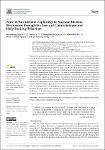Thông tin tài liệu
Thông tin siêu dữ liệu biểu ghi
| Trường DC | Giá trị | Ngôn ngữ |
|---|---|---|
| dc.contributor.advisor | Tam-Tri Le | - |
| dc.contributor.advisor | Hong-Kong To Nguyen | - |
| dc.contributor.advisor | Manh-Toan Ho | - |
| dc.contributor.advisor | Huyen T. Thanh Nguyen | - |
| dc.contributor.advisor | Quan-Hoang Vuong | - |
| dc.contributor.author | Minh-Hoang Nguyen | - |
| dc.date.accessioned | 2021-06-21T02:25:11Z | - |
| dc.date.available | 2021-06-21T02:25:11Z | - |
| dc.date.issued | 2021 | - |
| dc.identifier.uri | https://www.mdpi.com/1660-4601/18/7/3681 | - |
| dc.identifier.uri | https://dlib.phenikaa-uni.edu.vn/handle/PNK/1879 | - |
| dc.description | Q1 | vi |
| dc.description.abstract | On average, one person dies by suicide every 40 s. However, extant studies have largely focused on the risk factors for suicidal behaviors, not so much on the formation of suicidal thoughts. Therefore, we attempt to explain how suicidal thoughts arise and persist inside one’s mind using a multifiltering information mechanism called Mindsponge. Bayesian analysis with Hamiltonian Markov Chain Monte Carlo (MCMC) technique was run on a dataset of multinational students (N = 268) of an international university in Japan. Item 9 in the PHQ-9 was used to survey suicidal ideation. The associations among four main variables, namely, (i) suicidal ideation, (ii) help-seeking willingness (informal and formal sources), (iii) sense of connectedness, and (iv) information inaccessibility (represented by being international students), were tested in four models. Sense of connectedness is negatively associated with suicidal ideation, but its effect becomes less impactful when interacting with international students. The impact of a sense of connectedness on informal help-seeking willingness (toward family members) among international students is also lessened. Informal help-seeking is negatively associated with suicidal ideation, whereas formal help is positive. The findings support our assumption on three fundamental conditions for preventing suicidal thoughts: (i) a high degree of belongingness, (ii) accessibility to help-related information, and (iii) healthy perceived cultural responses towards mental health. Therefore, systematically coordinated programs are necessary to effectively tackle suicidal ideation. | vi |
| dc.language.iso | en | vi |
| dc.publisher | International Journal of Environmental Research and Public Health, 18 (7), 3681 | vi |
| dc.subject | suicidal ideation mechanism | vi |
| dc.subject | Bayesian inference | vi |
| dc.subject | sense of connectedness | vi |
| dc.subject | help-seeking behavior | vi |
| dc.title | Alice in Suicideland: Exploring the Suicidal Ideation Mechanism through the Sense of Connectedness and Help-Seeking Behaviors | vi |
| dc.type | Article | vi |
| dc.type | Working Paper | vi |
| eperson.identifier.doi | 10.3390/ijerph18073681 | - |
| Bộ sưu tập | ||
| Bài báo khoa học | ||
Danh sách tệp tin đính kèm:

